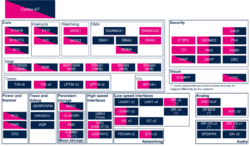- Last edited 10 months ago ago
TZC internal peripheral
Contents
1 Article purpose[edit]
The purpose of this article is to:
- briefly introduce the TZC peripheral and its main features
- indicate the level of security supported by this hardware block
- explain how it can be allocated to the runtime contexts and linked to the corresponding software components
- explain, when necessary, how to configure the TZC peripheral.
2 Peripheral overview[edit]
The TZC peripheral is used to filter read/write accesses to the DDR controller according to TrustZone access rights, and according to Non-Secure master Address ID (NSAID) on up to 9 programmable regions.
2.1 Features[edit]
Refer to the STM32MP13 reference manuals or STM32MP15 reference manuals for the complete list of features, and to the software components, introduced below, to see which features are implemented.
2.2 Security support[edit]
The TZC is a secure peripheral.
3 Peripheral usage and associated software[edit]
3.1 Boot time[edit]
The TZC is configured at boot time to setup DDR accesses. It is initially configured thanks to TF-A FW Configuration. OP-TEE redefined the TZC regions based on device tree.
3.2 Runtime[edit]
3.2.1 Overview[edit]
The TZC is a system peripheral and is controlled by the Arm® Cortex®-A7 secure.
3.2.2 Software frameworks[edit]
3.2.2.1 On STM32MP13x lines  [edit]
[edit]
| Domain | Peripheral | Software components | Comment | |
|---|---|---|---|---|
| OP-TEE | Linux | |||
| Security | TZC | OP-TEE TZC driver | ||
3.2.2.2 On STM32MP15x lines  [edit]
[edit]
| Domain | Peripheral | Software components | Comment | ||
|---|---|---|---|---|---|
| OP-TEE | Linux | STM32Cube | |||
| Security | TZC | OP-TEE TZC driver | |||
3.2.3 Peripheral configuration[edit]
The configuration is applied by the firmware running in the secure context.
This configuration is done in OP-TEE.
3.2.4 Peripheral assignment[edit]
3.2.4.1 On STM32MP13x lines  [edit]
[edit]
Click on the right to expand the legend...
Check boxes illustrate the possible peripheral allocations supported by STM32 MPU Embedded Software:
- ☐ means that the peripheral can be assigned (☑) to the given runtime context.
- ⬚ means that the peripheral can be assigned to the given runtime context, but this configuration is not supported in STM32 MPU Embedded Software distribution.
- ✓ is used for system peripherals that cannot be unchecked because they are statically connected in the device.
Refer to How to assign an internal peripheral to an execution context for more information on how to assign peripherals manually or via STM32CubeMX.
The present chapter describes STMicroelectronics recommendations or choice of implementation. Additional possiblities might be described in STM32MP13 reference manuals.
| Domain | Peripheral | Runtime allocation | Comment | ||
|---|---|---|---|---|---|
| Instance | Cortex-A7 secure (OP-TEE) |
Cortex-A7 non-secure (Linux) | |||
| Security | TZC | TZC | ✓ | ||
3.2.4.2 On STM32MP15x lines  [edit]
[edit]
Click on the right to expand the legend...
Check boxes illustrate the possible peripheral allocations supported by STM32 MPU Embedded Software:
- ☐ means that the peripheral can be assigned (☑) to the given runtime context.
- ⬚ means that the peripheral can be assigned to the given runtime context, but this configuration is not supported in STM32 MPU Embedded Software distribution.
- ✓ is used for system peripherals that cannot be unchecked because they are statically connected in the device.
Refer to How to assign an internal peripheral to an execution context for more information on how to assign peripherals manually or via STM32CubeMX.
The present chapter describes STMicroelectronics recommendations or choice of implementation. Additional possiblities might be described in STM32MP15 reference manuals.
| Domain | Peripheral | Runtime allocation | Comment | |||
|---|---|---|---|---|---|---|
| Instance | Cortex-A7 secure (OP-TEE) |
Cortex-A7 non-secure (Linux) |
Cortex-M4 (STM32Cube) | |||
| Security | TZC | TZC | ✓ | |||
4 How to go further[edit]
The TZC is an Arm® peripheral: TZC-400 TrustZone Address Space Controller[1]



